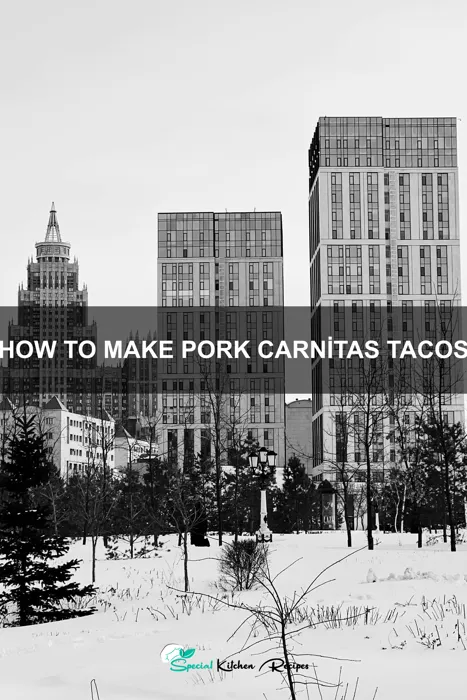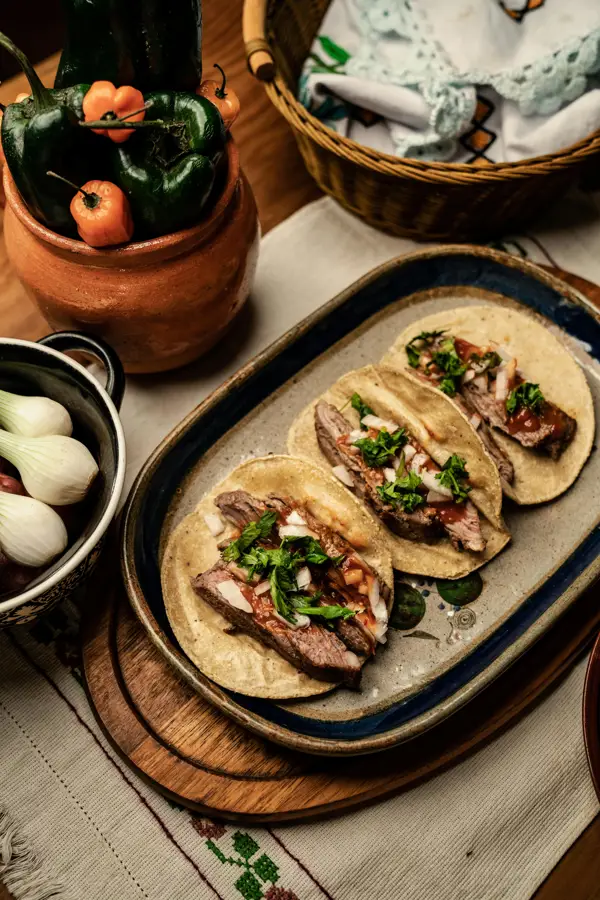Prepare yourself for a culinary journey to the heart of Mexico with this guide on how to make authentic Pork Carnitas Tacos. These succulent, slow-cooked pork tacos are far more than just a delicious meal; they represent a rich tapestry of Mexican history and culture. Carnitas, meaning little meats in Spanish, originated in the state of Michoacán, Mexico, and are deeply intertwined with the region’s agricultural traditions. For centuries, pigs have been raised in the area, providing a readily available and versatile protein source. The specific techniques for preparing carnitas evolved over generations, passed down through families and refined by regional variations.
The preparation of carnitas is a testament to the ingenuity of Mexican cuisine. Unlike many quick-cooking methods, carnitas rely on slow cooking, often using techniques like braising or confiting in lard. This slow process renders the pork incredibly tender, resulting in a melt-in-your-mouth texture that’s unparalleled. The use of lard, a traditional ingredient, adds a unique richness and flavor that’s difficult to replicate. Interestingly, the popularity of carnitas has exploded beyond Mexico’s borders, with countless restaurants and home cooks embracing this flavorful dish. In fact, according to recent market research, the carnitas market is experiencing significant growth, indicating a rising global demand for this authentic Mexican specialty.
Beyond their delicious taste, carnitas hold significant cultural weight in Mexico. They are frequently served at festive occasions, family gatherings, and celebrations. Carnitas represent a connection to heritage and tradition, a link to the culinary past that continues to thrive in modern times. The vibrant flavors and textures of carnitas are often complemented by a variety of traditional toppings, including chopped onions, cilantro, salsa, and lime wedges, all contributing to a sensory experience that encapsulates the essence of Mexican gastronomy. This recipe aims to guide you through the process of creating authentic carnitas at home, allowing you to share this beloved dish and its rich cultural significance with your loved ones.
Ingredients and Measurements
This recipe yields approximately 12-15 tacos, depending on the size of your tortillas.
For the Pork:
- 3 lbs boneless pork shoulder (also known as Boston butt). Choose a well-marbled cut for maximum tenderness and flavor. A leaner cut will result in drier carnitas.
- 1 large yellow onion, roughly chopped (approximately 1 ½ cups chopped)
- 4 cloves garlic, minced
- 2 oranges, juiced (approximately ½ cup fresh orange juice)
- 1 lime, juiced (approximately ¼ cup fresh lime juice)
- ½ cup chicken broth
- 2 tablespoons ground cumin
- 1 tablespoon chili powder
- 1 tablespoon smoked paprika
- 1 teaspoon dried oregano
- 1 teaspoon salt
- ½ teaspoon black pepper
- ½ teaspoon cayenne pepper (optional, for added heat)
- 2 bay leaves
For Serving:
- 12-15 small corn or flour tortillas
- Your favorite taco toppings! Suggestions include: chopped cilantro, diced white onion, shredded lettuce, pico de gallo, crumbled cotija cheese, sour cream or Mexican crema, pickled onions, and your favorite salsa.
Important Notes on Measurements:
Accuracy is key when it comes to seasoning. Use a kitchen scale for the most precise measurements of spices, especially if you’re making a large batch. While measuring cups are acceptable for the liquids and larger ingredients, consistent measurements will ensure the best flavor profile. Adjust the amount of cayenne pepper to your preferred level of spiciness. If you don’t have fresh orange and lime juice, you can substitute with bottled juice, but fresh is always best. Don’t be afraid to taste and adjust the seasoning as you go, adding more salt, lime, or spices as needed to achieve your desired flavor.
Pro Tip: For even more flavorful carnitas, consider marinating the pork shoulder in the orange juice, lime juice, and spices for at least 4 hours, or preferably overnight, before cooking.
Equipment List
Making delicious pork carnitas requires the right tools. This equipment list details everything you’ll need, from preparation to serving, ensuring a smooth and efficient cooking process. While some items might be substitutable, using the recommended equipment will yield the best results.
Large Dutch oven or heavy-bottomed pot (6-8 quart): This is crucial for braising the pork. A heavy-bottomed pot ensures even heat distribution, preventing scorching and promoting tender, flavorful carnitas. Avoid using thin-walled pots, as they may lead to uneven cooking and potential sticking.
Immersion blender or food processor: Once the pork is cooked, you’ll need to shred it. An immersion blender directly in the pot is the easiest method, quickly and efficiently creating the perfect texture. Alternatively, a food processor works well, but requires transferring the cooked pork, which can be slightly messier.
Meat thermometer: Accurate temperature monitoring is paramount for ensuring the pork is cooked safely and to the right tenderness. Invest in a reliable instant-read meat thermometer to check the internal temperature of the pork throughout the braising process. Aim for an internal temperature of at least 190°F (88°C) for safe consumption.
Large skillet or comal (12-inch): After shredding, you’ll want to crisp up the carnitas. A large skillet or a comal (a flat griddle) is perfect for rendering excess fat and achieving that desirable crispy exterior. A cast iron skillet is highly recommended for its superior heat retention.
Tongs: These are essential for safely handling the hot pork during shredding and crisping. Use long tongs to avoid burns and maintain a safe distance from the hot surfaces.
Measuring cups and spoons: Accurate measurements are key for consistent results. Use standard measuring cups and spoons to measure the ingredients precisely as outlined in the recipe.
Cutting board: A sturdy cutting board is needed for preparing the onions and other aromatics. Choose a large cutting board to accommodate the ingredients comfortably.
Sharp knife: A sharp knife is essential for efficiently chopping the onions and other vegetables. A dull knife is dangerous and will make the preparation process more difficult.
Serving dishes and tortillas: Once your carnitas are ready, you’ll need attractive serving dishes to present them beautifully. Don’t forget to have warm tortillas ready for assembling the tacos.
Optional: For extra convenience, consider using a slow cooker for the braising process. However, note that the crisping step will still require a skillet or comal.
Preparation of the Pork
The key to incredible carnitas is starting with high-quality pork. For this recipe, we’ll use 3 pounds of boneless pork shoulder (also known as Boston butt). This cut is ideal because it’s incredibly flavorful and renders beautifully, resulting in tender, juicy carnitas. You can also use a pork loin, but it will require a shorter cooking time and may be slightly less tender.
Begin by trimming away any excess fat. While some fat is essential for flavor and moisture, removing excessive layers will prevent overly greasy carnitas. Aim for a relatively even layer of fat remaining across the shoulder. Don’t be afraid to leave a good amount – about ¼ inch will do nicely. Too little fat and the pork will be dry.
Next, we’ll season the pork. In a large bowl, combine 2 tablespoons of ground cumin, 1 tablespoon of chili powder, 1 tablespoon of smoked paprika, 1 teaspoon of garlic powder, 1 teaspoon of onion powder, 1 teaspoon of dried oregano, ½ teaspoon of cayenne pepper (optional, for heat), 1 teaspoon of salt, and ½ teaspoon of black pepper. The spice blend is crucial; feel free to adjust to your preferred level of heat and smokiness. If you like a more vibrant orange hue, add a pinch of annatto powder.
Generously rub the spice mixture all over the pork shoulder, ensuring complete coverage. Really work the spices into the meat – this will enhance the flavor penetration during cooking. You can even use your hands to massage the spices into the pork for best results. Once seasoned, place the pork in a large resealable bag or a shallow dish, cover, and refrigerate for at least 2 hours, or preferably overnight. This allows the flavors to meld and penetrate the meat deeply.
Before cooking, remove the pork from the refrigerator 30 minutes before cooking to allow it to come to room temperature. This ensures even cooking. This step may seem minor, but it truly makes a difference in achieving perfectly cooked carnitas.
Now you’re ready to cook! Choose your preferred method – slow cooker, oven, or Instant Pot – and follow the instructions in the next section for succulent, melt-in-your-mouth carnitas.
Cooking the Pork (Braising/Slow Cooking)
This section details the braising process, crucial for achieving tender, flavorful carnitas. We’ll be using a combination of braising and slow cooking methods for optimal results. You’ll need approximately 3 lbs of pork shoulder (also known as Boston butt), cut into 2-3 inch chunks. Larger chunks ensure even cooking and prevent dryness.
Begin by seasoning the pork generously. In a large bowl, combine the pork chunks with 2 tablespoons of ground cumin, 1 tablespoon of smoked paprika, 1 tablespoon of chili powder, 1 teaspoon of oregano, 1 teaspoon of garlic powder, 1 teaspoon of onion powder, 1 teaspoon of salt, and ½ teaspoon of black pepper. Thoroughly coat each piece of pork with the spice mixture, ensuring even seasoning for consistent flavor throughout.
Heat 2 tablespoons of vegetable oil in a large Dutch oven or heavy-bottomed pot over medium-high heat. Brown the pork chunks in batches, ensuring not to overcrowd the pot. Browned pork adds depth of flavor to the final product. Once browned on all sides, remove the pork from the pot and set aside.
Add 1 large chopped onion and 4 cloves of minced garlic to the pot and sauté for about 5 minutes, until softened. Then, pour in 2 cups of your preferred broth (chicken or pork broth works well). Add 1 cup of orange juice (freshly squeezed is best!) for acidity and brightness. The liquid should almost cover the pork. If necessary, add more broth.
Return the browned pork to the pot. Bring the mixture to a simmer, then reduce the heat to low, cover the pot tightly, and braise for 3-4 hours, or until the pork is incredibly tender and easily shreds with a fork. Check the pork periodically and add more broth if necessary to prevent it from drying out.
Once the pork is cooked through, remove it from the pot and let it rest for about 15 minutes. Using two forks, shred the pork into small, manageable pieces. Discard any excess fat that has accumulated on the surface of the braising liquid.
For extra flavor and texture, you can return the shredded pork to the braising liquid and simmer it uncovered for another 15-20 minutes, allowing some of the liquid to reduce and the pork to become slightly caramelized. This step is optional but highly recommended for a more intense carnitas experience. Remember to taste and adjust seasoning as needed before serving.
Shredding the Pork
Once your pork is cooked to perfection – tender and easily pulling apart – it’s time to shred it. This step is crucial for achieving that classic carnitas texture. We’ll be shredding approximately 3 pounds of cooked pork shoulder, but adjust this based on your recipe.
First, remove the pork shoulder from the slow cooker or Dutch oven and let it rest for about 15-20 minutes. This allows the juices to redistribute throughout the meat, resulting in a more moist and flavorful final product. Do not skip this resting period!
Next, you have a few options for shredding. The easiest method is using two forks. Simply grab a large chunk of pork with one fork and use the second fork to pull the meat apart in a shredding motion. This works well for smaller batches, but can be tedious for larger quantities.
For larger quantities, consider using two meat claws. These specialized kitchen tools are designed specifically for shredding meat and make the process significantly faster and less strenuous. Meat claws offer superior control and efficiency, especially when dealing with larger cuts of meat.
Alternatively, you can use a stand mixer fitted with the paddle attachment. Carefully place the cooked pork into the bowl and mix on low speed until the meat is shredded. This method is very effective but requires some care to avoid over-mixing and creating a mushy texture. Start on the lowest speed and gradually increase if needed. Be mindful of the mixer’s power and avoid overloading it.
Regardless of the method you choose, aim for a consistent shred size. You want pieces that are easily manageable in a taco, but not so small that they become difficult to handle. Aim for shreds roughly 1/4 to 1/2 inch in length. Avoid over-shredding the pork, as this can result in a dry, stringy texture.
Once shredded, you can return the carnitas to the slow cooker or Dutch oven (if using) and gently stir in any accumulated juices, ensuring the meat is evenly moistened. This step helps to keep the carnitas tender and flavorful. You can also add your preferred seasonings at this stage, such as additional lime juice, cilantro, or your favorite taco seasoning blend.
Making the Salsa/Other Toppings
The perfect carnitas taco isn’t complete without vibrant, flavorful toppings. While the carnitas themselves are the star, the salsa and other additions elevate the experience to another level. We’ll focus on a classic pico de gallo and offer suggestions for other complementary options.
Pico de Gallo: This fresh salsa is incredibly easy to make and provides a bright counterpoint to the richness of the pork. For a medium-sized batch (enough for 4-6 tacos), you’ll need:
- 1 large tomato, diced (about 1 ½ cups)
- ½ medium white onion, finely diced (about ½ cup)
- ½ cup chopped cilantro
- 1 jalapeño, seeded and minced (adjust to your spice preference)
- 2 tablespoons lime juice (about 1 large lime)
- 1 teaspoon salt
- ½ teaspoon ground cumin (optional, for added depth)
Instructions: Gently combine all ingredients in a medium bowl. Avoid overmixing, as this can bruise the tomatoes and make the salsa watery. Let the salsa sit for at least 15 minutes to allow the flavors to meld. Taste and adjust seasoning as needed. For a smoother salsa, you can briefly pulse the ingredients in a food processor, but be careful not to over-process.
Other Topping Suggestions: To further enhance your carnitas tacos, consider these additions:
- Quick Pickled Onions: Thinly slice a red onion and soak it in a mixture of lime juice, water, and a pinch of sugar for at least 15 minutes. This adds a tangy crunch.
- Guacamole: A classic pairing! Use your favorite guacamole recipe or buy pre-made. The creamy avocado complements the rich pork beautifully.
- Shredded Cabbage or Lettuce: Adds a refreshing crunch and a lighter element to the tacos.
- Cotija Cheese: This firm, salty Mexican cheese crumbles beautifully and offers a salty, sharp contrast to the rich pork.
- Sour Cream or Mexican Crema: A dollop of either adds a creamy richness and a touch of tang.
Professional Tip: Prepare your toppings ahead of time. This allows the flavors to develop and makes assembling the tacos much smoother. Store salsas and pickled onions in airtight containers in the refrigerator until ready to use. Remember to taste and adjust seasoning before serving – every ingredient varies slightly.
Important Note: The quantity of toppings you’ll need will depend on the number of tacos you’re making and personal preference. Don’t be afraid to experiment and find your perfect combination of flavors and textures!
Recommendations
For the best Carnitas Tacos, slow cooking is key. Allowing the pork to simmer gently for several hours will result in incredibly tender and flavorful meat that easily shreds. Don’t rush the process! Experiment with different spices to find your perfect blend – chipotle peppers in adobo sauce add a delicious smoky heat, while cumin and oregano bring warm earthy notes. Consider adding a touch of orange juice or zest for brightness.
Serving suggestions are endless! Classic toppings include chopped cilantro, diced white onion, and a squeeze of lime. For extra flavor and texture, consider adding a dollop of your favorite salsa (pico de gallo, salsa verde, or even a roasted tomato salsa), crumbled cotija cheese, or a creamy avocado crema. Warm corn or flour tortillas are essential, ensuring they’re pliable enough to hold the generous filling. Don’t forget to serve with a side of your favorite Mexican rice and refried beans for a complete meal.
Storage: Leftover carnitas can be stored in an airtight container in the refrigerator for up to 3 days. They can also be frozen for up to 3 months. Reheat gently in a skillet or microwave before serving. To prevent drying out during reheating, add a splash of water or broth.
Complementary Dishes: Carnitas tacos pair wonderfully with a variety of sides. Consider serving them alongside Mexican street corn (Elote), a vibrant guacamole, or a simple Mexican salad with a lime vinaigrette. For a more substantial meal, consider serving them with Mexican rice, refried beans, and your choice of salsa.
Nutritional Information (per serving, approximate, will vary based on ingredients and portion size): Calories: 350-450, Protein: 25-35g, Fat: 20-30g, Carbohydrates: 20-30g. Note: This is an estimate and the actual nutritional content may vary depending on the specific ingredients used and the portion size. For accurate nutritional information, use a nutrition calculator with your specific recipe and ingredients.
Important Note: Always ensure your pork is cooked to an internal temperature of 145°F (63°C) to ensure food safety. Adjust spice levels to your preference. Enjoy!





